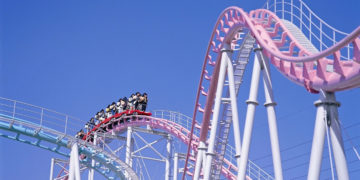Last Updated on 3 years by admin
Visiting Jeonju should be a part of your South Korea travel itinerary as it’s a beautiful city with some amazing places to discover!
Jeonju in South Korea is known for its ancient downtown, which is referred to as the Hanok village. The term “hanok” refers to traditional Korean homes, which are often lovely. Jeonju should be on your list of things to see in South Korea.
Lonely Planet included Jeonju in its “Best Attractions in Asia” list in 2016, which is still proudly displayed on the city’s tourist map. Despite all of Jeonju’s activities, it is still off the Western tourist’s radar, resulting in fewer people.
While you’re in this charming city, here are some top things to do in Jeonju!
Wandering Through the Hanok Village
Jeonju Hanok Village is the best place to start exploring the city. This village is home to over 800 traditional Korean homes, which have been beautifully preserved. You can explore the homes, stroll through the streets, and even stay overnight in a hanok if you want to experience traditional Korean culture.
The traditional streets of this village are not only jam-packed with breathtaking structures and ancient architecture, as one might expect from Korea’s culinary capital, but they’re also filled with street food vendors selling all types of delectable foods. Rent and wear a hanbok to stroll the lovely atmospheric streets eating South Korean street cuisine while enjoying the full experience.
Visit the Gyeonggijeon Shrine
The Gyeonggijeon Shrine is located near the hanok village. Visiting Gyeonggjieon is a must if you want to visit Jeonju.
This Shrine was erected in the early years of the 15th century, shortly after King Taejo’s death, establishing the Joseon dynasty. For the same reason, several shrines had previously been erected in the country. They were all destroyed by the Japanese and subsequently rebuilt.
You may see the Royal Portrait Museum in addition to paying a visit to the Shrine. This is where you can view King Taejo’s portrait, among other things.
Shop at Nambu Market
The Nambu Market is a massive local market in Jeonju, where you can find everything from seafood to pajamas to souvenirs to kitchen goods. It is a great place to find unique items that you can’t find anywhere else. Although it is generally tranquil during the day, a Friday and Saturday night market in Jeonju fills with bustling vendors when the town comes alive at night.
Eat Bibimbap at its origin
Bibimbap is a Korean dish that is traditionally made with rice, vegetables, and meat. It is typically served in a stone bowl, which helps to keep the food warm. Bibimbap is one of Korea’s most popular dishes, and it is said to have originated in Jeonju.
Many restaurants in Jeonju serve Bibimbap, but you can also find it at street food stalls. Be sure to try the Jeonju version of this dish, which is made with beef and a variety of vegetables.
Hwangbangsan Nature Trail
The Hwangbangsan Scenic Walk is a popular excursion in the Jeonju area! This light nature path is ideal for both beginners and experts—and it’s also enjoyable whether you have or don’t have hiking gear. Be sure not to miss out on Jeonju’s natural beauty!
Take a stroll through Jaman Mural Village
The Jaman Mural Village is located to the south of Jeonju’s traditional Hanok Village. From the Omokdae viewpoint, you can cross a bridge and reach this hamlet. The Jaman Mural Village is a must-see in Jeonju because it demonstrates the city’s artistic and trendy side.
The streets of Jeonju offer a number of beautiful murals painted by talented locals. Many individualistic cafés and bistros line these dark alleys. They frequently have outside terraces where you may relax and enjoy the views of Jeonju from above.
Visit Jeondong Catholic Church
This Catholic Church is one of the largest and considered to be one of the most beautiful churches in South Korea. It’s been used in many Korean shows as a backdrop, but it’s still utilized for daily mass in Jeonju in the mornings.
Take a rest in the Hanbyeokdang Pavilion
A lovely pavilion overlooking a little lake and the wooded hill next to it can be found at the edge of Jeonju city. It’s a nice place to sit back and soak up Korea’s stunning scenery. You might almost think you’re floating back to Korea hundreds of years ago in this area.
Visit Jeonju Hyanggyo
The perfectly preserved Confucian school, which is about 15 minutes on foot from the center of Hanok Village, is another notable feature of Jeonju. The buildings are preserved in their ancient appearance, and it’s easy to picture Confucian scholars strolling its corridors. Today, portions of the school are used to teach Confucian values to children in Jeonju.
This institution is well-known for its Gingko trees, which turn a brilliant golden in the fall. They were placed there to signify learning and education. The school’s ginkgo tree stands near the entrance and is almost 400 years old.
Take A Snap At PUNGNAM Gate
Pungnam Gate (Pungnammun) is one of the four gates that served as entry points to Jeonju’s ancient city. It is the only surviving door, though wood panels have covered it for some time.
Pungnam Gate, like many other attractions in Jeonju, was erected during the Joseon Dynasty. It was built in 1768.
Pungnammun isn’t a must-see attraction in Jeonju; rather, it’s a photo opportunity. It is most magnificent during the evening when it is illuminated. The top of the door is out of reach.
Visit Donggosa Temple
The little but peaceful Donggosa Temple is a nice destination. The Dongosa Temple is a cultural heritage object designated as Jeonbuk No. 2 in the UNESCO World Heritage Centre’s inventory of cultural sites. A 50cm bamboo forest walkway connects you to Chimyeongjasan Martyrs’ Mountain, a famous night view location in Jeonju. At Donggosa Temple, go for a stroll and enjoy the sunset as well as the night view.
Jeonju is a city with many hidden treasures waiting to be discovered. From the delicious food to the ancient sights, there is something for everyone in Jeonju. Whether you’re a tourist or a local, be sure to add these items to your bucket list!
18,983 total views, 2 views today

















